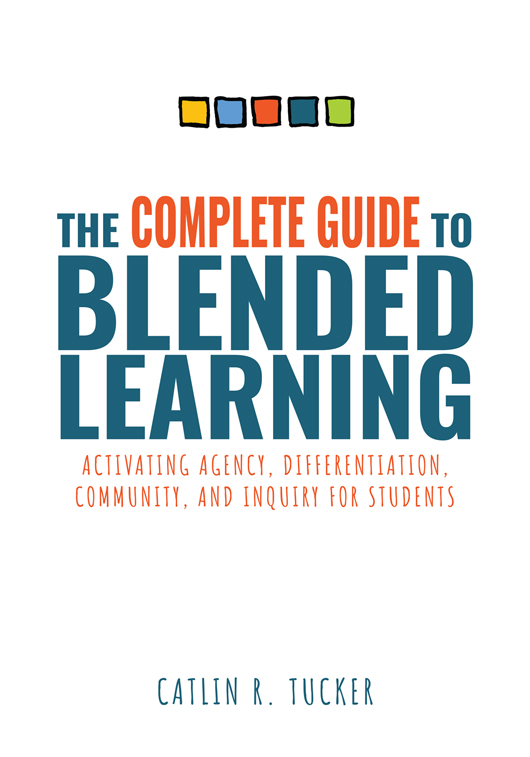Free Reproducibles
The Complete Guide to Blended Learning
Activating Agency, Differentiation, Community, and Inquiry for Students
Embrace the new normal of hybrid teaching and enhance student learning. Connecting theory and reflective experience, this book equips educators with blended learning strategies for both classroom and online environments.
Benefits
- Gain insight on why blended instruction provides paths for effective, student-centered teaching.
- Learn to navigate flexible learning landscapes.
- Understand different collaborative and community-oriented strategies for successful blended teaching.
- Utilize thoughtful reflection questions to examine your own school or district.
- Discover strong theoretical frameworks and models for online and off-line instruction.
TABLE OF CONTENTS
Chapter 1: The Basics of Blended Learning
Chapter 2: Your Blended Learning Technology Toolbox
Chapter 3: Teachers as Designers of Learning Experiences
Chapter 4: Teachers as Instructors and Connectors
Chapter 5: Teachers as Facilitators of and Partners in Learning
Chapter 6: A Dynamic Learning Community
Chapter 7: The 5E Instructional Model and Student-Centered Inquiry
Chapter 8: How to Take Blended Learning to the Next Level
Conclusion
Glossary
REPRODUCIBLES
Introduction
Chapter 1
- Figure 1.3: Project-Based Learning Proposal Form
- Chapter 1: The Basics of Blended Learning—Reflect and Discuss
Chapter 2
- Figure 2.1: Checklist—Setting Up Your Virtual Classroom
- Figure 2.3: Activity—Thinking Through SAMR
- Chapter 2: Your Blended Learning Technology Toolbox—Reflect and Discuss
Chapter 3
- Figure 3.3: Station Rotation Template for In-Class Lesson
- Figure 3.4: Virtual Station Rotation Lesson Template
- Figure 3.5: Whole-Group Rotation Template
- Figure 3.7: Three-Part Flipped Lesson Template
- Figure 3.8: Playlist Model Template
- Chapter 3: Teachers as Designers of Learning Experiences—Reflect and Discuss
Chapter 4
- Figure 4.3: Hook the Group Strategy-Planning Template
- Figure 4.4: I Do, We Do, Groups Do, You Do Strategy-Planning Template
- Figure 4.5: Real-Time Feedback Planning Document
- Figure 4.6: Present-Pause-Discuss (Repeat) Strategy-Planning Template
- Chapter 4: Teachers as Instructors and Connectors—Reflect and Discuss
Chapter 5
- Figure 5.2: Welcome Routine Goal-Setting Activity
- Figure 5.6: The 4 Ps Conferencing Framework
- Chapter 5: Teachers as Facilitators and Partners in Learning—Reflect and Discuss
Chapter 6
- Figure 6.1: Random Autobiography Sentence Starters
- Figure 6.6: SEL Activity Template
- Chapter 6: A Dynamic Learning Community—Reflect and Discuss
Chapter 7
- Figure 7.2: Project Zero Thinking Routine—“See/Think/Wonder”
- Figure 7.3: Project Zero Thinking Routine—“Connect, Extend, Challenge”
- Figure 7.4: 3-2-1 Post-Interview Reflection
- Figure 7.5: Concept Map
- Figure 7.6: Review and Practice Choice Board
- Figure 7.8: “Would You Rather?” Performance Tasks
- Figure 7.10: 5E Instructional Model Template
- Chapter 7: The 5E Instructional Model and Student-Centered Inquiry—Reflect and Discuss
Chapter 8
- Figure 8.3: Then-and-Now Reflection Chart
- Chapter 8: Taking Blended Learning to the Next Level—Reflect and Discuss
SUGGESTED RESOURCES
BOOKS
- Cohen, R. K., Opatosky, D. K., Savage, J., Stevens, S. O., & Darrah, E. P. (2021). The metacognitive student: How to teach academic, social, and emotional intelligence in every content area. Bloomington, IN: Solution Tree Press.
- DuFour, R., DuFour, R., Eaker, R., Many, T., & Mattos, M. (2016). Learning by doing: A handbook for Professional Learning Communities at Work® (3rd ed.). Bloomington, IN: Solution Tree Press.
- Grafwallner, P. (2021). Not yet . . . and that’s OK: How productive struggle fosters student learning. Bloomington, IN: Solution Tree Press.
- Schimmer, T. (2016). Grading from the inside out: Bringing accuracy to student assessment through a standards-based mindset. Bloomington, IN: Solution Tree Press.
- Townsley, M., & Wear, N. L. (2020). Making grades matter: Standards-based grading in a secondary PLC at Work. Bloomington, IN: Solution Tree Press.
WEBSITES
Chapter 1
Chapter 2
Chapter 3
Chapter 4
Chapter 5
Chapter 7
Chapter 8

